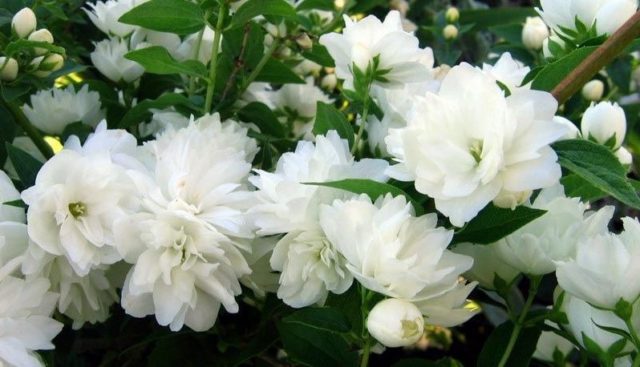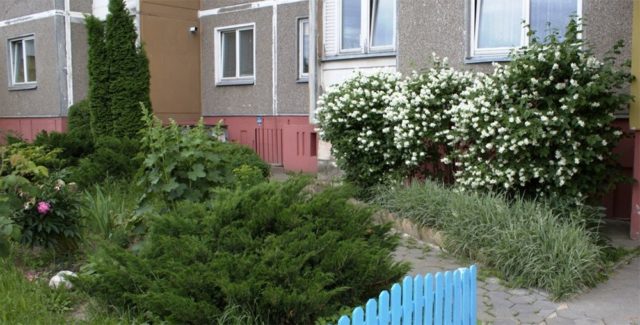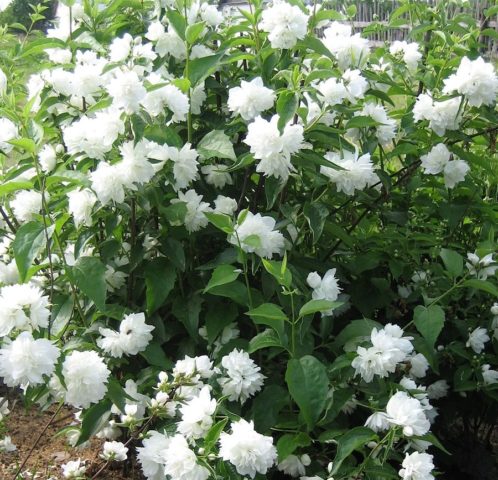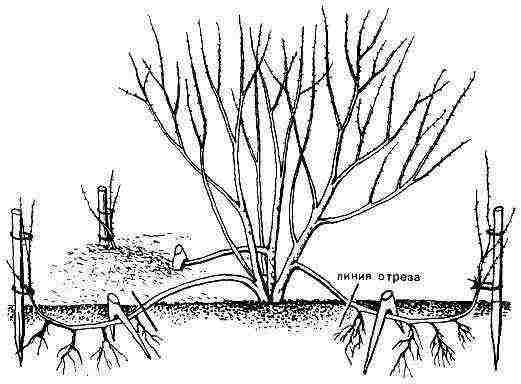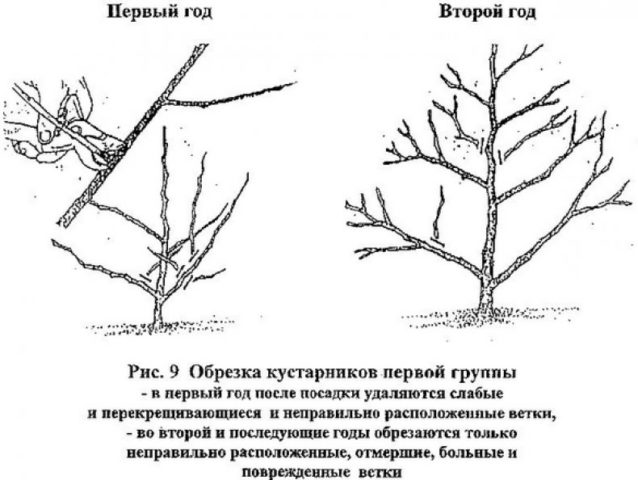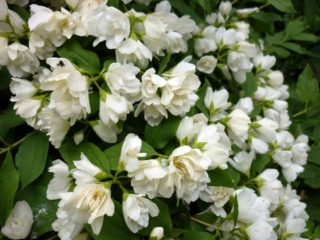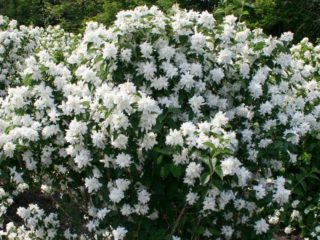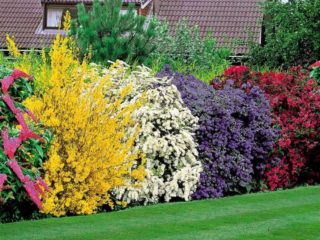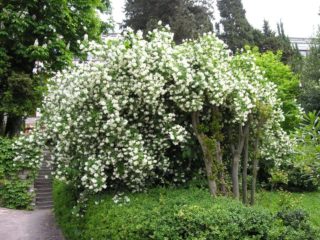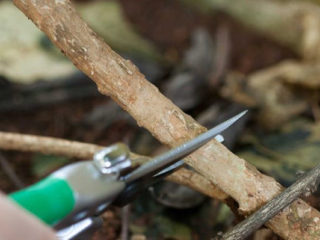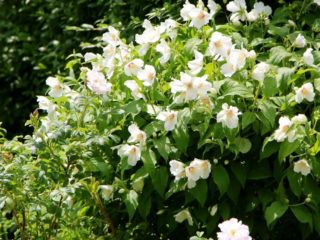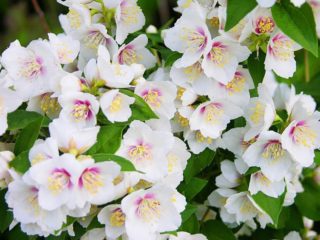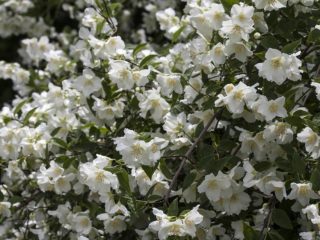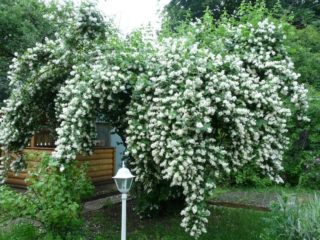Content
At the beginning of summer, garden jasmines bloom in the gardens and garden plots of central Russia, filling the air with a pleasant, strawberry aroma. Mock orange Pearl, like all other garden jasmines, is able to decorate every garden corner or not very attractive place; become the highlight of a country house composition or highlight perennial herbaceous plants with their decorative effect.
Description of Jasmine Pearl
Garden jasmine is the popular name for mock orange, due to the similarity of flowering and the fragrant aroma of the flowers of these ornamental crops. In fact, these are different plants. And, if mock orange is grown in the central and southern regions of Russia, then jasmine grows in Egypt, the Mediterranean and Southeast Asia. Gardeners and gardeners call mock orange "false" or garden jasmine.
Deciduous, low-growing - up to 1.3 - 1.5 m in height, a shrub with rich green foliage and red-brown, curved shoots - this is the mock orange variety Zhemchug, which is the brainchild of the selection of Academician N. Vekhov.“False” jasmine belongs to the Hydrangeaceae family with an average flowering period. The small shrub has a spherical, neat crown, which allows it to be planted even under the windows of the house.
How the mock orange Zhemchug blooms
Snow-white, double, gigantic, up to 7 cm in diameter, the flowers of the mock orange variety Zhemchug abundantly cover flexible shoots, harmoniously contrasting with the green foliage. The incredibly lush bloom of jasmine lasts about 20 days, starting at the end of June. At this time, the garden is filled with a fragrant fragrance emitted by white flowers with a pearlescent tint and pearl tint. Dense, umbrella-shaped inflorescences densely cover the crown of jasmine, surprising with their resemblance to large pearls. Flowering is affected by the place where mock orange is planted, the composition of the soil and care, which is completely simple. Even beginners in gardening can successfully grow this amazing shrub on their own plot. From the description and visual photo, it becomes clear that the Zhemchug mock orange blooms elegantly and magnificently, being at this time a true decoration of every garden.
Main characteristics
Garden jasmine variety Pearl is quite frost-resistant, tolerates low temperatures down to 25 degrees below zero without freezing. Therefore, in the conditions of the southern and central zones, it does not require shelter for the winter. It responds well to regular application of mineral and organic fertilizers, increasing the number of new shoots. Mock orange Zhemchug grows quickly in fertile, breathable soils with good drainage. It does not tolerate waterlogging, saline, waterlogged soils. However, it reacts poorly to drought, which immediately affects the condition of the Pearl leaves, which lose turgor. The shrub pleases with abundant flowering only in sunny, without shading, places.Mock orange is resistant to pests and diseases if it is provided with optimal growing and care conditions.
Features of reproduction
Garden jasmine of the Pearl variety is propagated in several ways:
- seeds;
- cuttings and layering;
- dividing the bush.
Mock orange easily takes root using any of the above methods. Seeds are sown on the surface of fertile soil with the addition of sand, sprinkled with peat and moistened. After 2-3 leaves appear, the seedlings are planted and hardened in the fresh air as they grow. In autumn, young plants are planted in a permanent place and covered with spruce branches with the arrival of cold weather.
For layering, healthy, strong mock orange branches are selected, which are bent to pre-dug trenches and fixed. They are sprinkled with soil, regularly moistened, and hilled until they take root. In autumn, new jasmine seedlings with a developed root system and young cuttings are separated and planted on a separate ridge. After 2 years, young and strong mock orange seedlings Zhemchug are transplanted to a permanent place.
Reproduction of garden jasmine by layering:
Cuttings for propagating mock orange Pearls are prepared in spring or autumn. In the first case, they are placed in a root-forming solution and planted in greenhouses. In the second, they are stored until spring in a basement with zero air temperature and planted only in the spring. They are buried 1 cm and cared for in the standard way. Afterwards, the young mock orange seedlings are hardened. In autumn, garden jasmine is planted in open ground in a separate place. The plant is transplanted to a permanent location only after 2 years.
The most popular, effective way to propagate mock orange is to divide the bush, which involves digging up an adult bush and dividing its root system into parts using a sharp knife.The separated seedlings are immediately planted in a permanent place and watered abundantly. The procedure is carried out mainly in the fall. In the middle zone - in early to mid-October, so that the mock orange roots have time to get stronger by winter.
Planting and care
In order for the Zhemchug mock orange to delight with its delightful flowering and decorative crown, as in the photo, planting is carried out in well-lit, not shady areas. In the shade and even partial shade, the plant stretches out, its branches become weak and thin, and flowering becomes rare and scarce. You cannot plant mock orange of any variety, including Zhemchug, on waterlogged soils with close groundwater. Under such conditions, its root system will begin to rot, which will subsequently lead to the death of the bush. Otherwise, agrotechnical practices for mock orange are standard: watering, fertilizing, pruning and, in cold areas, if necessary, shelter for the winter.
Recommended timing
Mock orange seedlings Zhemchug are planted in the spring, in early or mid-April in areas with fairly cold winters. Over the summer, they manage to get stronger and develop a strong root system in order to survive the winter well. In the southern regions, mock orange is also planted in the fall, in early or mid-October.
Site selection and soil preparation
To plant mock orange varieties Zhemchug, choose a place with direct sunlight, protected from cold winds and drafts. The ideal option would be the south side of the house, fence or building. First prepare a fertile soil mixture of sand, humus and leaf soil in the ratio (1:2:3). You should also take care of drainage from expanded clay, coarse sand or gravel.
Landing algorithm
- Planting holes are dug 60x60 in size, which is optimal for the root system of Zhemchug mock orange, at a distance of 0.7 m from each other for hedges and 1.3 m for group plantings.
- A drainage layer of at least 20 cm is poured onto the bottom, and a little prepared fertile soil is placed on top, which will prevent stagnation of groundwater that is not tolerated by jasmine.
- The mock orange seedling is installed vertically, making sure that the root collar is buried in the soil no more than 2 cm.
- Sprinkle the top with soil, compact it and water it abundantly.
- The tree trunk circle is mulched with fallen leaves, humus or peat.
Growing rules
Garden jasmine is undemanding to care. When planted correctly, it has enough bright sunlight and nutrients in the soil for active growth and development. However, minimal care measures for the Zhemchug mock orange still need to be carried out. For this:
- Mock orange is planted only in illuminated sunny places;
- the soil is fertilized and drained;
- regularly water and feed the bush;
- carry out timely pruning of bushes.
Watering schedule
Immediately after planting, young seedlings are shed generously at the rate of 20 liters of water per plant. In the future, watering the mock orange is carried out less frequently, once a week. During drought, the watering rate is increased to 3-4 times a week, but be sure to ensure that the soil is not waterlogged.
Weeding, loosening, mulching
Weeding of the trunk circle of garden jasmine is carried out when weeds appear, loosening - 3 - 4 times per season.Mulching with leaf humus immediately after planting allows you to maintain the required level of moisture in the soil and saturate it with nutrients. Mandatory mulching with peat, fallen leaves, and humus is carried out before cold weather.
Feeding schedule
Feeding is carried out according to certain rules:
- Every year, in early spring, mock orange is fed with slurry diluted with water (1:10). Apply one bucket of fertilizer per bush.
- From the second year of development, jasmine requires spring mineral feeding, which is in addition to the mandatory organic one. To prepare it, take superphosphate (20g), potassium sulfate and urea (15g each) and dilute it in 1 bucket of water. This amount of mineral fertilizer is enough to feed 2 adult Zhemchug mock orange.
- The plant also needs fertilizing after flowering for the formation of buds for the next year and the growth of new shoots. To do this, superphosphate (30g), potassium sulfate (15g) and wood ash (100g) are diluted in 1 bucket of water. This amount of solution is designed to water 2 adult mock orange bushes.
Trimming
Pruning is one of the main agrotechnical techniques when caring for mock orange variety Zhemchug. The first pruning is carried out even before planting the seedling, removing all unattractive shoots that interfere with the formation of a spectacular crown. Before planting, the jasmine seedling should have 2 - 3 strong branches with several healthy buds located at the base. Next, pruning is carried out a year after the first flowering, cutting out weak, thin shoots and faded inflorescences. After this, sanitary pruning of mock orange is carried out annually in early spring, eliminating all damaged, weak, frozen branches. At the same time, you can carry out a shaping haircut to give the crown a decorative shape.To do this, remove the upper part of the growth by 2/3 of the length.
Preparing for winter
In the conditions of central Russia, the mock orange Zhemchug does not need shelter for the winter. The exception is young, immature seedlings up to 3 years old, planted in a permanent place in the fall. They must be covered with spruce branches and sprinkled with fallen snow. Jasmine variety Pearl tolerates frosts up to 25 degrees, so in colder regions it needs to be covered with non-woven material or burlap. To additionally protect the root system from hypothermia before cold weather, the tree trunk circle is mulched with fallen leaves or peat. To prevent damage to branches during heavy snowfalls, the bush is freed from a layer of snow.
Pests and diseases
Garden jasmine Pearl is a plant resistant to diseases and pests, which, with proper agricultural practices, is practically not exposed to them. Culture is most vulnerable:
- To the spider mite;
- leafy green weevil;
- aphids.
Pests are controlled using insecticides. As a preventative measure, it is advisable to treat bushes in spring or autumn during pruning with Karbofos. In addition, it is necessary to promptly remove fallen leaves and provide the plant with regular fertilizing, which makes it healthier, stronger, and, therefore, more resistant to diseases and pests. You should not overwater garden jasmine: it becomes weak from waterlogging.
A video that clearly demonstrates the gardener’s experience in growing garden jasmine:
Conclusion
Chubushnik Zhemchug belongs to the dwarf shrubs, and therefore is widely used in landscape design when decorating borders, front gardens, and flower beds. It looks great together with other flower crops in garden compositions or in group planting to delimit the territory into zones.
